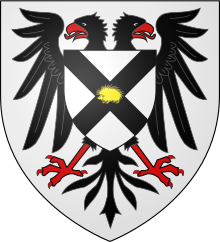
Earl of Warwick is one of the most prestigious titles in the peerages of the United Kingdom. The title has been created four times in English history, and the name refers to Warwick Castle and the town of Warwick.

The title Earl of Morton was created in the Peerage of Scotland in 1458 for James Douglas of Dalkeith. Along with it, the title Lord Aberdour was granted. This latter title is the courtesy title for the eldest son and heir to the Earl of Morton.
The title Earl of Winton was created in the Peerage of Scotland and later in the Peerage of the United Kingdom. It is currently held by the Earl of Eglinton.

Baron FitzWalter is an ancient title in the Peerage of England. It was created on 24 June 1295 for Robert FitzWalter. The title was created by writ, which means that it can descend through both male and female lines.

Lord Herries of Terregles is a hereditary title in the Peerage of Scotland. It was created in 1490 for Herbert Herries with remainder to his heirs general.

Earl of Surrey is a title in the Peerage of England that has been created five times. It was first created for William de Warenne, a close companion of William the Conqueror. It is currently held as a subsidiary title by the Dukes of Norfolk.
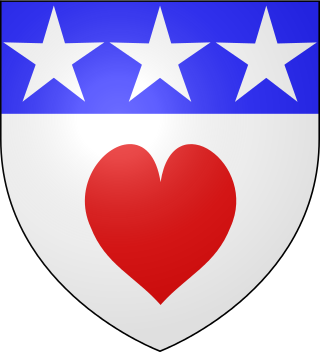
This page is concerned with the holders of the forfeit title Earl of Douglas and the preceding feudal barons of Douglas, South Lanarkshire. The title was created in the Peerage of Scotland in 1358 for William Douglas, 1st Earl of Douglas, son of Sir Archibald Douglas, Guardian of Scotland. The Earldom was forfeited by James Douglas, 9th Earl of Douglas, in 1455.
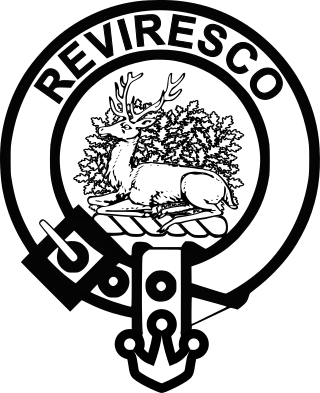
Clan Maxwell is a Scottish clan of the Scottish Lowlands and is recognized as such by the Lord Lyon King of Arms. However, as the clan does not currently have a chief, it is considered an armigerous clan.
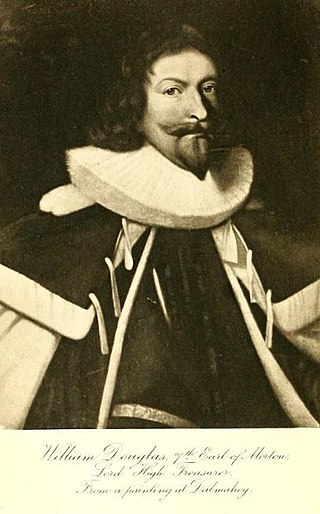
William Douglas, 7th Earl of Morton was a grandson of the 6th Earl of Morton. He was Treasurer of Scotland, and a zealous Royalist.

Earl of Kilmarnock was a title created twice in the Peerage of Scotland for the Boyd family. It was first created in 1454 for Robert Boyd, Great Chamberlain of Scotland. It was created a second time in 1661 for William Boyd, 10th Lord Boyd. Both titles were forfeited in 1746.
William Maxwell, 5th Earl of Nithsdale, was a Roman Catholic member of the Scottish nobility who took part in the Jacobite rising of 1715. He was attainted with his titles forfeited. However, Lord Nithsdale made a celebrated escape from the Tower of London by changing clothes with his wife's maid the day before he was due to be executed. The lordship of Herries of Terregles was later restored to his descendants and remains extant.
The title Baron Ferrers of Chartley was created on 6 February 1299 for John de Ferrers, son of Robert de Ferrers, 6th Earl of Derby. The daughter of the 6th Baron Ferrers of Chartley, Anne, married Walter Devereux who was summoned to parliament as Lord Ferrers in her right. Their descendants became Earls of Essex and the peerage was forfeited in 1601 on the attainder of Robert Devereux, 2nd Earl of Essex, but restored to his son Robert in 1604, on whose death in 1646 the peerage fell into abeyance. The abeyance was terminated in 1677 when Robert Shirley, a grandson of one of the sisters of the 3rd Earl of Essex, was summoned as Lord Ferrers of Chartley with precedence to the original creation. In 1711, Shirley was created the 1st Earl Ferrers, but the Earldom and Barony separated at his death, the barony going to Elizabeth Shirley, the daughter of his eldest son, while the earldom went to his second son. On the 1741 death of Elizabeth Shirley, 15th Baroness Ferrers of Chartley and wife of the Earl of Northampton, the peerage again briefly fell into an abeyance that was resolved in 1749 by the death of two of the three heiresses, leaving the surviving daughter, Charlotte Compton, wife of the Marquess Townshend, as 16th Baroness Ferrers of Chartley. The barony continued, merged with the marquessate, until the death of George Ferrars Townshend, 3rd Marquess Townshend in 1855, when it again fell into abeyance between his two sisters and their heirs. It remains in abeyance.

The titles Baron Montacute or Baron Montagu were created several times in the Peerage of England for members of the House of Montagu. The family name was Latinised to de Monte Acuto, meaning "from the sharp mountain"; the French form is an ancient spelling of mont aigu, with identical meaning.
There have been two baronetcies created for members of the Haggerston, later Constable Maxwell-Scott family, one in the Baronetage of England and one in the Baronetage of the United Kingdom. Only one creation is extant as of 2008. The Haggerston, later Constable Maxwell-Scott Baronetcy, of Haggerston in the County of Northumberland, was created in the Baronetage of England on 15 August 1642 for Thomas Haggerston, of Haggerton Castle, Northumberland, a loyal Royalist who served as a colonel in the army of King Charles I. The Haggerston were recusant in the 17th century and the estates were sequestered and forfeit to the Commonwealth of England in 1649 but were repurchased by the first Baronet in 1653. The line of the fourth Baronet failed on the death of the twelfth Baronet in 1972. The title reverted to the line of William Haggerston, second son of the third Baronet and younger brother of the fourth Baronet. In 1746 he inherited estates in Yorkshire from his great-uncle Sir Marmaduke Francis Constable, 4th and last Baronet, of Everingham, and assumed the surname of Constable in lieu of his patronymic. In 1758 he married Winifred, daughter of Robert Maxwell, titular sixth Earl of Nithsdale, and assumed by Royal licence the additional surname of Maxwell. Winifred was considered to be the heiress to the Scottish lordship of Herries of Terregles held by her father. Constable-Maxwell built a new house at Everingham Park on the Constable estate in Yorkshire.

Terregles House was a late 18th-century country house, located near Terregles, in the historical county of Kirkcudbrightshire around 2 miles west of Dumfries in Scotland. It replaced an earlier tower house, which had served as the seat of the Lords Herries, and later the Earls of Nithsdale, until William Maxwell, the 5th Earl, forfeited his titles in 1716.
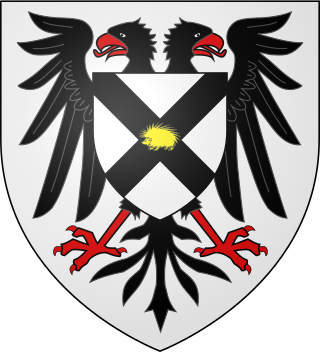
Robert Maxwell, 1st Earl of Nithsdale, was a Scottish nobleman. He succeeded his brother as 10th Lord Maxwell in 1613, and was created Earl of Nithsdale in 1620. General of Scots in Danish-Norwegian service during the Thirty Years' War. A loyal supporter of Charles I and a prominent Catholic, he lost his titles and estates in 1645, dying on the Isle of Man in 1646.
John Maxwell, 8th Lord Maxwell was a Scottish Catholic nobleman. In 1581 he was created Earl of Morton, and in 1587 he travelled to Spain where he took part in the planning of the Spanish Armada.
John Maxwell, 9th Lord Maxwell was a Scottish Catholic nobleman. He escaped from Edinburgh Castle in 1607, and in 1608 shot the Laird of Johnstone. For these crimes, he was executed and his titles were forfeit.
Marmaduke Constable-Maxwell, 11th Lord Herries of Terregles, was Lord Lieutenant of the East Riding of Yorkshire from 1880 and Lord-Lieutenant of Kirkcudbrightshire from 1885 until his death.
William Constable-Maxwell, 10th Lord Herries of Terregles was a Scottish peer and a landowner in England and Scotland. In 1858 he was restored to the peerage of Lord Herries of Terregles which had been lost by an ancestor in 1716.
